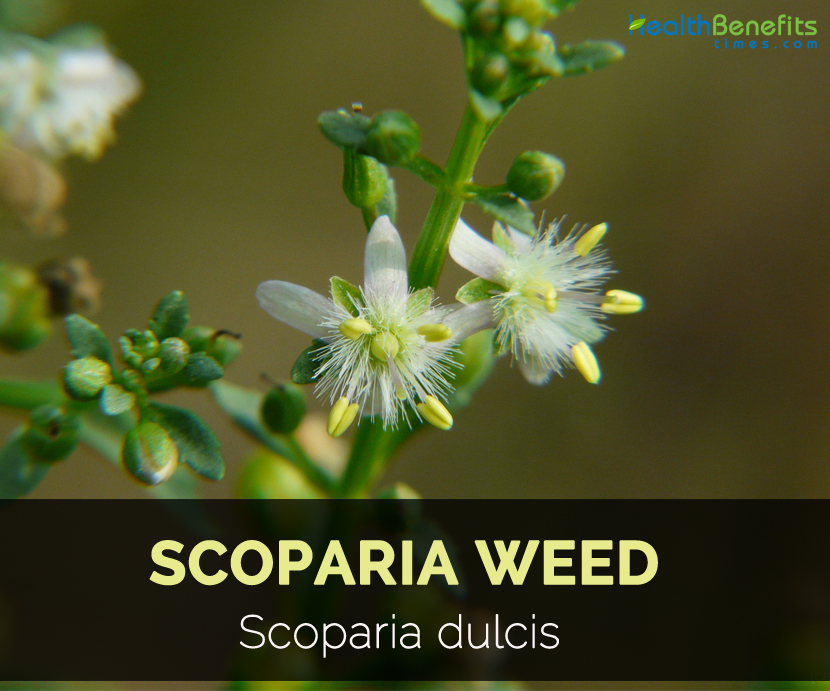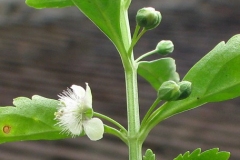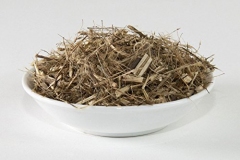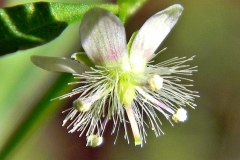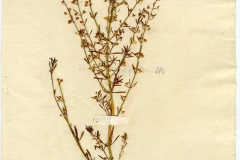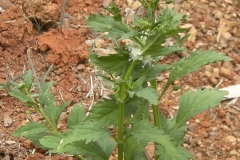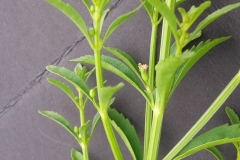Plant description
It is an erect, much branched, smooth, herbaceous, or half-woody plant belonging to Scrophulariaceae Juss. (Figwort family). The plant normally grows about 25 to 80 centimeters in height. The plant is found growing in cropping areas, roadsides, tracks, pastures, fence lines, firebreaks, rangelands, railway lines, eroded banks, gardens, waste areas and disturbed sites in temperate and semi-arid regions. The stems and leaves are initially green in color, however they often turn yellow, orange, red or brown in color as they mature. Stems and branches are somewhat hairy (i.e. pubescent). This plant reproduces by seed. When the plant reaches maturity it usually breaks off at the base of the stem and rolls along in the wind like a ‘tumbleweed’, thereby dispersing its seed over large areas.
Leaves
The leaves are opposite or verticillate in three. They are simple and sessile. The lamina is oblanceolate, 2.5 to 5 cm long and 1.5 cm wide. The base is attenuated by acute corner, forming a pseudo-petiole. The top corner is wide. Both sides are smooth and riddled with green glands, brilliant. The margin is entire in the lower half of the leaf blade and toothed in the upper half.
Flower
The flowers are solitary or in pairs in the axils of the leaves. They are a bluish color. They are carried by a peduncle 6 to 8 mm long. The calyx consists of 5 sepals almost free to the base. They are elliptical in shape, tapering at the top. They are finely hairy. The corolla consists of 4 petals, rarely 5, free nearly to the base. They are oval, apiculate at the top. The entire calyx and corolla is 3 to 4 mm long. The four stamens have anthers 2-celled equal. The ovary is surmounted by a filiform style not exceeding the corolla.
Fruit
The fruit is a dehiscent capsule, ovoid, surmounted by the style. It is 4 mm long and contains numerous seeds. When ripe, it opens in two valves. The seeds are extremely small, they measure 0.1 mm long. They are obconical shape.
Traditional uses and benefits of Scoparia Weed
- This plant is considered an antibiotic, an antidote, an aphrodisiac, a blood purifier, an emetic, a febrifuge, a hepatic, a hypoglycemic and a stomachic.
- The roots and leaves are traditionally used in India, Indochina and Southeast Asia as analgesic, diuretic and antipyretic to treat gastric disorders such as diarrhea and dysentery, as well as cough, bronchitis, hypertension, hemorrhoids and Insect bites.
- Research has shown that the plant contains a number of medically active compounds.
- In the Philippines, roots, leaves, and tops used as infusion for gastralgia, diarrhea, and dysentery.
- Root decoction is used for fevers.
- Decoction of leaves and tops are used for intestinal affections.
- Decoction of dried material is used for cold and fever, enteritis, diarrhea, beriberi, edema, difficulty in urination.
- For miliaria, rub the squeezed juice from fresh plant.
- For headaches associated with fevers, leaf or whole plant is macerated in water is drunk copiously when cooled.
- It is used as a children’s remedy for coughs and diuretic.
- In Liberia decoction is taken for gravel and kidney complaints.
- Decoction is applied as fomentation on bruises and contusions.
- In Brazil decoction is used for bronchitis and broncho-pulmonary afflictions.
- In the Antiles, plant is used as emollient; decoction is used as enema and for local baths.
- Decoction is used for diarrhea, colic, and indigestion.
- Roots are used as diuretic.
- In Costa Rica decoction of leaves are used as stomachic; infusion is used as emmenagogue.
- In India, China and Southeast Asia, it is used for pain, fever, dysentery, diarrhea, cough, bronchitis, hypertension, piles and insect bites.
- In Vietnam, it is used for snakebites and antidote for cassava intoxication. Also, for pimples, impetigo, ulcers and eczema.
- In Taiwan, it is used for hypertension.
- Murong tribe in Bangladesh used the plant in the treatment of malaria.
- In Sierra Leone, it is used for remittent fevers and gonorrhea.
- For the latter, a cold infusion, sweet and mucilaginous, is drunk repeatedly.
- In Nigeria, plant used in the management of sickle cell anemia.
- In Nicaragua, plant is used for malaria.
- In India, it is used for gonorrhea, to induce labor, and diabetes.
- In India, leaves are ground to a paste applied topically for wound healing.
- In China, it is used for herpes.
- In Burma and India, herb infusion is used as mouthwash for infected gums.
- In Nepal, leaves are used for stomach ache and venereal diseases.
- In Brazilian folk medicine, it is used for bronchitis, gastric disorders, hemorrhoids, insect bites and skin wounds.
- In the Guianas, Scoparia dulcis is boiled with Momordica charantia and infusion of Tradescantia elongata, and the liquid drunk as purgative. Plant is boiled along with Lantana camara and Pteridium aquilinum, and the water used as an herbal bath.
- It is traditionally used in treatment of diabetes, dysentery, earache, fever, gonorrhea, headaches, jaundice, snake bite, stomach problems, toothache and warts.
- Tender leaves are considered highly medicinal especially for diabetic patient
- It is used to treat toothaches.
- It is dried and used as an herbal tea to treat blood in urine.
- Drug prepared from this plant is used in the treatment of diabetes.
- Leaf is used to treat fevers and nausea.
- Root is used for excessive menstruation and gonorrhea, also to treat nausea and dizzy spells.
- Raw root crushed and pressed on tooth for toothaches.
- It is used in tropical America to treat conditions such as digestive problems, lung conditions, fevers and skin problems.
- It is used to treat digestive problems, pulmonary complaints, fevers and skin disorders.
- The roots, leaves and tops are traditionally used in India, Indo-China and South-East Asia as an analgesic, diuretic and antipyretic, to treat gastric disorders such as diarrhea and dysentery, and also for cough, bronchitis, hypertension, hemorrhoid and insect bites.
- Oral administration of amellin relieves symptoms of glycosuria, reduces hyper-glycaemia and increases RBC count. ‘
- It has also been found helpful in anemia, albuminuria, ketonuria, retinitis and other complications associated with diabetes mellitus.
- The whole plant is used for treating a wide range of disorders including diabetes, herpes, coughs and colds, fevers, nausea, dizziness, and as an antidote for snakebites and cassava intoxication.
- In low doses, often in milk, it is used to relieve vomiting in infants, whilst in larger does it is used to induce vomiting to clear out the digestive system.
- A decoction of the plant is drunk as a treatment for remittent fever and gonorrhea, and also to induce labor.
- A cold decoction of the plant is taken as a remedy for gravel and kidney complaints.
- The fresh or dried plants are used externally to treat a wide range of skin problems, including pimples, impetigo, ulcers, eczema, bruises and contusions.
- An infusion of the herb is used as a mouthwash for infected gums.
- The leaves are chewed to treat cough; they first taste bitter and later sweet (like licorice).
- They were formerly used in the treatment of diabetes.
- The leaves are macerated in warm water and drunk copiously when cooled in the treatment of feverish headaches.
- Plant (fresh or dried) are used as an aid for treatment of kidney stones, stomach ailments, diabetes, hypertension, hemorrhoids, bronchitis, antipyretic, analgesic and urinary disorders.
- It relieves pain and urinary tract infections.
- Externally it is used fresh or dried plants to treat various skin problems such as ulcers, bruises, pimples, eczema and impetigo.
Culinary Uses
- Infusion of seeds, soaked overnight is considered a cooling drink.
- Leaves are used for making tea; also, to sweeten well water.
- Young shoots consumed as vegetable.
- Tender leaves are chewed, and are used as vegetable.
- People place bunches of the branches in containers of drinking water, and claim that the water is thus kept cool, as if iced.
Other Facts
- In Trinidad’s santowah ceremony, sweet broom is used to sprinkle holy water.
- The plant is sometimes used as a sand binder.
- The bushy stems are much used to make temporary brooms for sweeping floors, and there is a belief that they destroy fleas.
- The fresh or dried plants are said to kill fleas, lice and intestinal worms.
References:
https://pdfs.semanticscholar.org/29f1/594e17f98c4276a5d35fe0b8cc57a651f997.pdf
https://www.itis.gov/servlet/SingleRpt/SingleRpt?search_topic=TSN&search_value=34029#null
https://npgsweb.ars-grin.gov/gringlobal/taxonomydetail.aspx?id=33402
https://pfaf.org/user/Plant.aspx?LatinName=Scoparia+dulcis
https://en.wikipedia.org/wiki/Scoparia_dulcis
https://scialert.net/fulltextmobile/?doi=pharmacologia.2012.344.347
http://medicinalplants.us/scoparia-dulcis-l-sweet-broomweed
Comments
| Scoparia Weed Quick Facts | |
|---|---|
| Name: | Scoparia Weed |
| Scientific Name: | Scoparia dulcis |
| Origin | Distributed throughout tropical and subtropical regions of India, America, Brazil, West Indies, and Myanmar. |
| Colors | Brown |
| Shapes | Capsules |
| Name | Scoparia Weed |
|---|---|
| Scientific Name | Scoparia dulcis |
| Native | Distributed throughout tropical and subtropical regions of India, America, Brazil, West Indies, and Myanmar. |
| Common/English Name | Sweet Broom Wort, Sweet Broom Weed |
| Name in Other Languages | Hindi: Mithipatti, Ghodatulsi; Tamil: Sarakkotthini; Bengali: Bon-dhonya; Malayalam: Kallurukki; Spanish: Escobilla; English: Licorice weed, Scoparia-weed, Sweet-broom; Portuguese: Vassoura de botão, Vassourinha, tapeiçava, tapixaba, tupixava, vassourinha-doce, vassourinha-miúda Nepal: Chinijhar; Bangladesh: Bondhonia, dujhanga; Indonesia: Djakatuwa, gindjé menir gindjé djepun, , ginje jepun, jakatuwa, ginje menir, rumput patimah; Thailand: Kratai chaam yai, mafia duean ha, yaa hua maeng hun; Philippines: Hibi-hibihan, kacha-kachahan, isa-isa, isisa, malismalisan, mala-anis, malaamis, sampalokan; Vietnam: cam thao nam, Cam thao dat, da cam thao; Japan: Seitaka-kanabiki-sô; French Guiana: Balai-doux, herbe à balai sauvage, herbe à balai, petit balai à grains; Benin: Vivitèton; Burkina Faso: Boroémia, kouiguin, guékan, timin-timin; Congo: Ginge, oye, oyê; Gabon: Buko-bu-lyamba, dugadji-du-bakongu, buko-bwa-lyamba, dugandaga-dwa-dimbu, évoyè, kaké-lyamba, ézombolo, lépèrè, mulyalyamba, ndènghè, munyanyanga, ogandag-igondjo, ogoi-a-dyamba, ogoï-a-lyamba, ogoi-a-lyamba, pito-di-mbodu, osimyale, voyé, woyè; Ivory Coast: Boroémia, guékan; Madagascar: Anatsina, famafatambo, famafampanavy, mamiaho, jamalamprika, tsinjiajia; Niger: kabou beri, argumm, puma fâda; Nigeria: Atioto usa, mayinmayin, bimobimo, mesaenmesen gogoro, misimis-gogo, omisinmisin gogoro, olomu yinrin, ufu ija; Sierra Leone: Pondo livali |
| Parts used | Whole plant, barks, leaves, roots |
| Plant Growth Habit | Annual erect |
| Soil | Well-drained |
| Plant Size | 1 m tall |
| Root | Profusely branched, pale yellow, straight, 10-15 cm long |
| Leaf | Obovate-oblong to oblanceolate, 1.4 – 3.5 x 0.8 -1.5 cm |
| Flowering Time | Summer and Autumn |
| Flower | Small, white, 4-5 mm in diameter |
| Fruit shape & size | Capsules |
| Fruit color | Brown |
| Seed | Minute |


